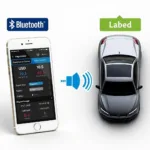Finding the best car diagnostic code scanner can feel like navigating a maze, especially with countless options flooding the market. Whether you’re a seasoned mechanic or a car enthusiast looking to do some DIY repairs, a reliable diagnostic scanner is an indispensable tool. This guide will equip you with the knowledge to choose the perfect scanner for your needs, ensuring you’re never left in the dark when your car throws its next code.
What to Look for in a Car Diagnostic Code Scanner
Before diving into specific models, let’s break down the key features that differentiate a good scanner from a great one:
- Functionality: Do you need a basic code reader or a more advanced scanner capable of live data streaming and bi-directional control?
- Vehicle Compatibility: Ensure the scanner supports your car’s make, model, and year.
- User Friendliness: A user-friendly interface with clear menus and intuitive navigation is crucial.
- Durability and Build Quality: Opt for a scanner built to withstand the rigors of a workshop environment.
- Software Updates: Regular software updates ensure compatibility with the latest vehicle models and diagnostic protocols.
- Price: Set a budget beforehand to narrow down your choices.
Types of Car Diagnostic Code Scanners
- Code Readers: Entry-level devices designed to read and clear basic diagnostic trouble codes (DTCs).
- OBD-II Scanners: Offer more advanced features like live data streaming, freeze frame data, and emissions readiness checks.
- Professional Scanners: Comprehensive tools used by mechanics and technicians, offering extensive diagnostic capabilities, including bi-directional control, module coding, and advanced programming functions.
Understanding Diagnostic Trouble Codes (DTCs)
Diagnostic trouble codes are standardized codes that indicate a specific malfunction within your vehicle’s systems. When your car’s onboard computer detects a problem, it generates a DTC, storing it in its memory.
DTC Structure:
- The first character indicates the system the code relates to (e.g., “P” for Powertrain).
- The second character refers to a specific subsystem (e.g., “0” for Fuel and Air Metering).
- The last two digits specify the actual fault within that subsystem.
Benefits of Using a Car Diagnostic Code Scanner
Investing in a good car diagnostic code scanner offers several advantages:
- Quick and Accurate Diagnosis: Identify car problems swiftly and accurately, saving you time and potential misdiagnoses.
- Cost Savings: Avoid unnecessary trips to the mechanic by diagnosing and potentially fixing issues yourself.
- Preventative Maintenance: Monitor your car’s health and address minor problems before they escalate into major repairs.
- Increased Knowledge: Gain a deeper understanding of your vehicle’s systems and their inner workings.
Choosing the Right Scanner for Your Needs
The “best” car diagnostic code scanner depends entirely on your individual needs and budget.
DIY Enthusiasts: An OBD-II scanner with live data streaming and freeze frame data capabilities is an excellent choice. Look for scanners with a user-friendly interface and a wide range of supported vehicles.
Professional Mechanics: A professional-grade scanner with bi-directional control, module coding, and advanced programming functions is essential. Consider scanners with robust software, regular updates, and excellent technical support.
Conclusion
A car diagnostic code scanner is a valuable tool for any car owner, empowering you with the knowledge to understand and address your vehicle’s needs. By understanding the different types of scanners, their features, and your specific requirements, you can choose the best car diagnostic code scanner that fits your budget and empowers you to take control of your car’s maintenance.


